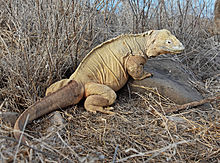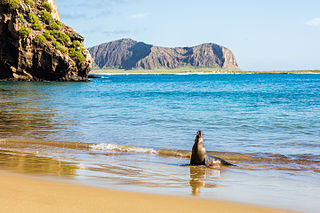
The Galápagos Islands, part of the Republic of Ecuador, are an archipelago of volcanic islands distributed on either side of the equator in the Pacific Ocean surrounding the centre of the Western Hemisphere. Located 906 km (563 mi) west of continental Ecuador, the islands are known for their large number of endemic species that were studied by Charles Darwin during the second voyage of HMS Beagle. His observations and collections contributed to the inception of Darwin's theory of evolution by means of natural selection.

The Charles Darwin Foundation was founded in 1959, under the auspices of UNESCO and the World Conservation Union. The Charles Darwin Research Station serves as headquarters for The Foundation, and is used to conduct scientific research and promote environmental education.

The marine iguana, also known as the sea iguana, saltwater iguana, or Galápagos marine iguana, is a species of iguana found only on the Galápagos Islands (Ecuador). Unique among modern lizards, it is a marine reptile that has the ability to forage in the sea for algae, which makes up almost all of its diet. Large males are able to dive to find this food source, while females and smaller males feed during low tide in the intertidal zone. They mainly live in colonies on rocky shores where they bask after visiting the relatively cold water or intertidal zone, but can also be seen in marshes, mangrove and beaches. Large males defend territories for a short period, but smaller males have other breeding strategies. After mating, the female digs a nest hole in the soil where she lays her eggs, leaving them to hatch on their own a few months later.

Jasminocereus is a genus of cacti with only one species, Jasminocereus thouarsii, endemic to the Galápagos Islands, territorially a part of Ecuador. In English it is often called the candelabra cactus. At maturity it has a branched, treelike habit, and may be up to 7 m (23 ft) tall. The stems are made up of individual sections with constrictions between them. Its creamy white to greenish flowers open at night and are followed by greenish to reddish fruits.

The woodpecker finch is a monomorphic species of bird in the Darwin's finch group of the tanager family, Thraupidae. They are a non-migratory species and are endemic to the Galapagos Islands. The diet of a woodpecker finch revolves mostly around invertebrates, but also encompasses a variety of seeds. Woodpecker finches, like many other species of birds, form breeding pairs and care for young until they have fledged. The most distinctive characteristic of woodpecker finches is their ability to use tools to for foraging. This behaviour indicates that they have highly specialized cognitive abilities. Woodpecker finches have also shown the ability to learn new behaviours regarding tool use via social learning. Not all populations of woodpecker finches use tools equally as often, as this is influenced by the environment in which they live.

Española Island is part of the Galápagos Islands. The English named it Hood Island after Viscount Samuel Hood. It is located in the extreme southeast of the archipelago and is considered, along with Santa Fe, one of the oldest, at approximately four million years. A popular tourist stop, Isla Española is the most southerly island in the Galápagos Archipelago. The climate is very dry, like most of the Archipelago. But due to the flatness of the island, it is the driest of these islands, with only a few inches of rain per year. It is about a 10- to 12-hour trip by boat from Isla Santa Cruz.
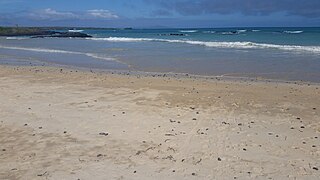
Santa Fe Island, also called Barrington Island after admiral Samuel Barrington, is a small island of 24 square kilometres (9.3 sq mi) which lies in the centre of the Galápagos archipelago, to the southeast of Santa Cruz Island. Geologically it is one of the oldest; volcanic rocks of about 4 million years old have been found. The vegetation of the island is characterized by brush, palo santo trees and stands of a large variety of the prickly pear cactus Opuntia echios.

North Seymour is a small island near Baltra Island in the Galápagos Islands. It was formed by uplift of a submarine lava formation. The whole island is covered with low, bushy vegetation.

Galápagos National Park, established in 1959 and beginning operations in 1968, is Ecuador's first national park and a UNESCO World Heritage Site.

The small tree finch is a species of bird in the Darwin's finch group of the tanager family Thraupidae. It has a grasping beak with curved culmens. Its natural habitats are subtropical or tropical dry forests and subtropical or tropical dry shrubland. During the non-breeding season it is known to form large groups with small ground-finches.

The medium ground finch is a species of bird in the family Thraupidae. It is endemic to the Galapagos Islands. Its primary natural habitat is tropical shrubland. One of Darwin's finches, the species was the first which scientists have observed evolving in real-time.

The small ground finch is a species of bird in the tanager family Thraupidae. Endemic to the Galápagos Islands, it is common and widespread in shrubland, woodland, and other habitats on most islands in the archipelago. It commonly feeds on small seeds and parasites from the skins of Galápagos land and marine iguanas and Galápagos tortoises.

The common cactus finch or small cactus finch is a species of bird in the Darwin's finch group of the tanager family Thraupidae. It is endemic to the Galapagos Islands, where it is found on most islands, with the notable exception of Fernandina, Española, Genovesa, Darwin and Wolf. Most of these islands are inhabited by its close relative, the Española cactus finch.

The Galápagos mockingbird is a species of bird in the family Mimidae. It is endemic to the Galápagos Islands, Ecuador.
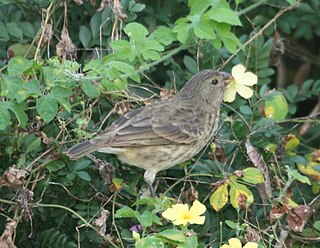
The vegetarian finch is a species of bird in the Darwin's finch group of the tanager family Thraupidae. It is the only member of the genus Platyspiza. It is endemic to the Galápagos Islands. Its natural habitats are subtropical or tropical dry forests and subtropical or tropical moist montane forests.
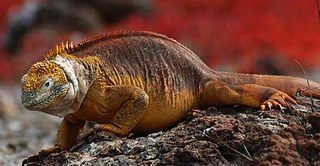
The Galapagos land iguana is a species of lizard in the family Iguanidae. It is one of three species of the genus Conolophus. It is endemic to the Galápagos Islands (Ecuador), in the dry lowlands of Fernandina, Isabela, Santa Cruz, North Seymour, Baltra, and South Plaza Islands.

The hybrid iguana is a first-generation hybrid, the result of intergeneric breeding between a male marine iguana and a female Galapagos land iguana on South Plaza Island in the Galápagos Islands, where the territories of the two species overlap.

Conolophus marthae, the Galápagos pink land iguana, is a species of lizard of the family Iguanidae. This critically endangered iguana is native only to the Wolf Volcano in northern Isabela Island of the Galápagos (Ecuador). It has a pink body with some dark stripes, prompting some to call it the pink iguana or the Galápagos rosy iguana. The species was first discovered in 1986 and was identified as a separate species, distinct from the Galápagos land iguana, early in 2009. This species is the only example of ancient diversification in the genus Conolophus and is one of the oldest events of divergence ever recorded in the Galápagos.
Howard L. Snell is an American ecologist and professor at the University of New Mexico. His research and conservation efforts have focused on the Galapagos land iguanas, which were in danger of extinction.

Microlophus albemarlensis, the Galápagos lava lizard, also known as the Albemarle lava lizard, is a species of lava lizard. It is endemic to the Galápagos Islands, where it occurs on several islands in the western archipelago: the large islands Isabela, Santa Cruz, Fernandina, Santiago and Santa Fe, as well as several smaller islands: Seymour, Baltra, Plaza Sur, Daphne Major and Rábida. It is the most widespread of the Galápagos species of Microlophus, the others only occurring on single islands. Some authors however, consider populations on Santiago, Santa Cruz, and Santa Fe to be distinct species. The species is commonly attributed to the genus Microlophus but has been historically placed in the genus Tropidurus.
